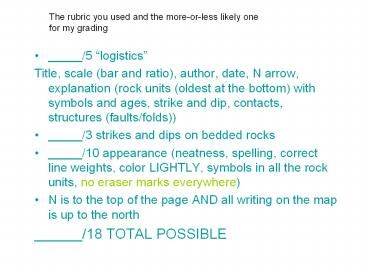_____/5%20 - PowerPoint PPT Presentation
Title:
_____/5%20
Description:
3 strikes and dips on bedded rocks _/10 appearance (neatness, ... Faulting occurred after. emplacement of the basalt, although precise timing is unknown. ... – PowerPoint PPT presentation
Number of Views:14
Avg rating:3.0/5.0
Title: _____/5%20
1
The rubric you used and the more-or-less likely
one for my grading
- _____/5 logistics
- Title, scale (bar and ratio), author, date, N
arrow, explanation (rock units (oldest at the
bottom) with symbols and ages, strike and dip,
contacts, structures (faults/folds)) - _____/3 strikes and dips on bedded rocks
- _____/10 appearance (neatness, spelling, correct
line weights, color LIGHTLY, symbols in all the
rock units, no eraser marks everywhere) - N is to the top of the page AND all writing on
the map is up to the north - ______/18 TOTAL POSSIBLE
2
Nancy who?
date
Which way is N?
Way too heavy lineweight
Only one???
Whats on The other side?
EXPLANATION
TOO Dark and unlabelled
(Symbols)
ORDER!!
And ages
?
____
?
Need the WHOLE contact
N ratio scale
Some title! And move to top of page
Topo base from SP Crater 7.5 quadrangle
3
ABSTRACT _____/2 title _____/3 location _____/5
rock types _____/10 volcanic/structural evolution
4
The abstract summarizes the entire paper. It may
be called an executive summary in some cases.
It should not be a detailed, blow-by-blow
description of every single aspect of the paper,
but it should contain enough information that
the reader will gain an appreciation for what
the paper is about. It should tell what the
study is about, why it was done, and what the
main conclusions are.
5
An abstract does NOT need to include details of
location, but it should include concise
descriptions of the RESULTS of your work. Thus
The rocks at SP Crater were studied is NOT
acceptable, but Rock types at SP Crater
include Triassic alluvium, Precambrian basalt,
and Ordovician mudstone is great (the
difference? the first tell me what you did,
which is obvious anyway, and the second tells
me what you found, which is what Im after). So,
you will want to include a few words about where
SP Crater is (three to five words, after is
located), the rock types (in stratigraphic order
please), and the distinguishing features of the
volcano and the area. AVOID THE PASSIVE VOICE
as much as possible (what are better ways to say
the basalt was seen or phenocrysts of olivine
were found?).
6
Structure and stratigraphy of the Lake Mary
area by GLG 240
Lake Mary is located 16 km southeast of
Flagstaff, AZ, along Lake Mary Road. The rock
layers are flat lying and include Permian
Coconino Sandstone, Permian Kaibab
Limestone, Triassic Moenkopi Formation, and
Tertiary basalt. The Coconino Sandstone
is cross bedded and friable. Grains are medium
to coarse, well sorted, and rounded. Cross
bedding varies from high to low angle and is in
several directions. The Kaibab Limestone is
well cemented and massive. Weathered surfaces
are strongly pitted and the rock effervesces in
HCl. The Moenkopi Formation consists of layers
of differing resistance to weathering and
thickness. Thicker, more-resistant layers
are coarser than thinner, less-resistant layers.
Lenses of platey siltstone are rarely cross
bedded. Basalt disconformably overlies the
Moenkopi Formation with an intervening baked
soil horizon.
7
The valley in which Lake Mary lies is an example
of a graben structure. A drill core taken from
Lake Mary shows that the stratigraphy below Lake
Mary matches that of outcrops on the mesas on
either side of the lake. Joints in the Kaibab
Limestone parallel the fault on the northeastern
side of the graben. Paleozoic and Mesozoic
rocks were deposited in environments that varied
from eolian (Coconino Sandstone) to marine
(Kaibab Limestone. Tertiary basalt was derived
from an unknown vent in the San Francisco
Volcanic Field. Faulting occurred
after emplacement of the basalt, although precise
timing is unknown.































